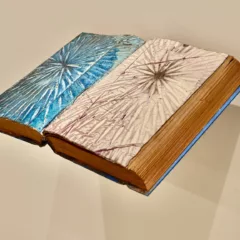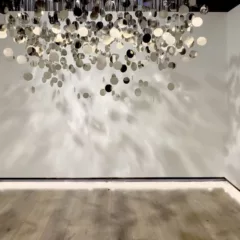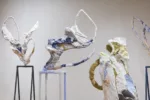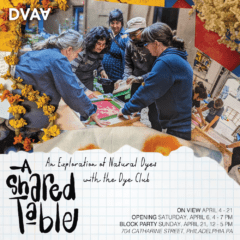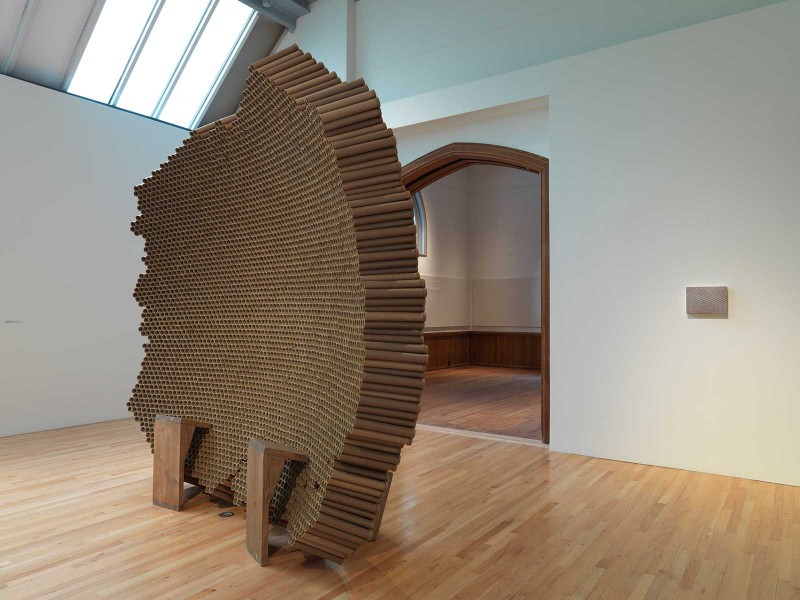
Five works of art comprise Emil Lukas’ exhibit at PAFA’s Morris Gallery. Yes, five. And not only are the pieces awesome, but their spare presence makes the austere, skylight-lit Morris Gallery look stunningly beautiful. Okay, the highlight of the show, the sculpture “Large Lens” pictured here, composed of glued-together cardboard tubes, commands the gallery, and it is huge, a good 10 feet in both the vertical and horizontal, and two-and-a half feet wide, and it is curved like one of those giant, otherworldly communication satellite dishes you see here and there. And notwithstanding its size and pedestrian components, “Large Lens” is an enchanting plaything—more on that below. But the four other works by Lukas, though unequal in size, are equally formidable and engaging. So, what you have here is a gorgeous skylit gallery and five totally absorbing works of art which must be seen and experienced to be believed. I should leave it at that.
The “Large Lens”
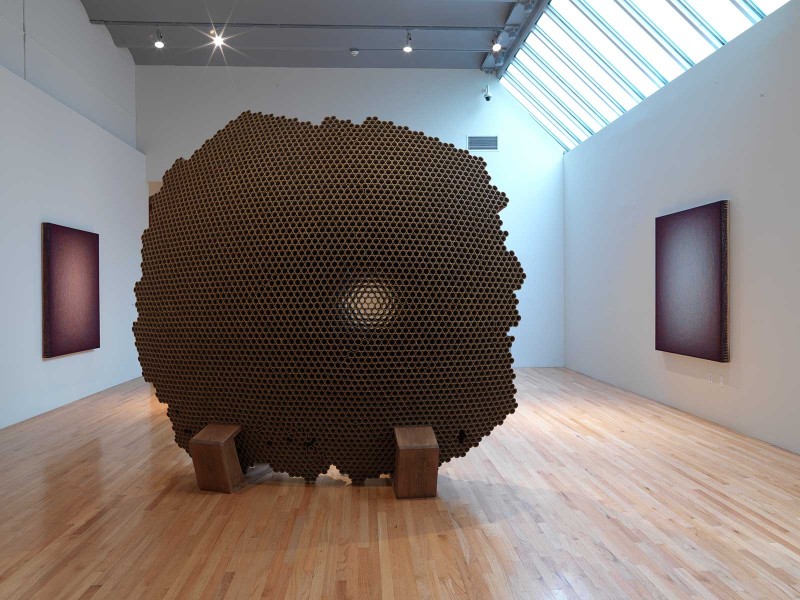
“Large Lens” was conceived by Lukas to be an interactive lens that breaks down the physical elements of seeing on a large scale. The sculpture thus serves as a portal into the gallery, changing the way the viewer experiences the space. Likewise, the physical structure of the piece changes as you move around it.
Facing into the gallery, you will be on the concave side of the lens. Pace the sculpture’s length and an illusory orb of white light glows through the hollow cardboard tubes. The orb shadows your movement, contracting or expanding depending upon your distance from the piece. You might feel as if you’re taking the moon, slightly obscured by clouds, for a walk. From the convex side, the orb, which likewise changes character with the movement of the viewer, is larger and more diffuse, and the ocular impression is quite different, but no less intriguing. See the optical changes of “Large Lens” in a video on the artist’s website.
Experiencing “Large Lens” is like being in the presence of some of the light and space work of James Turrell: that is, the experience is intended to be an act of discovery, and it is.
“Cloud”
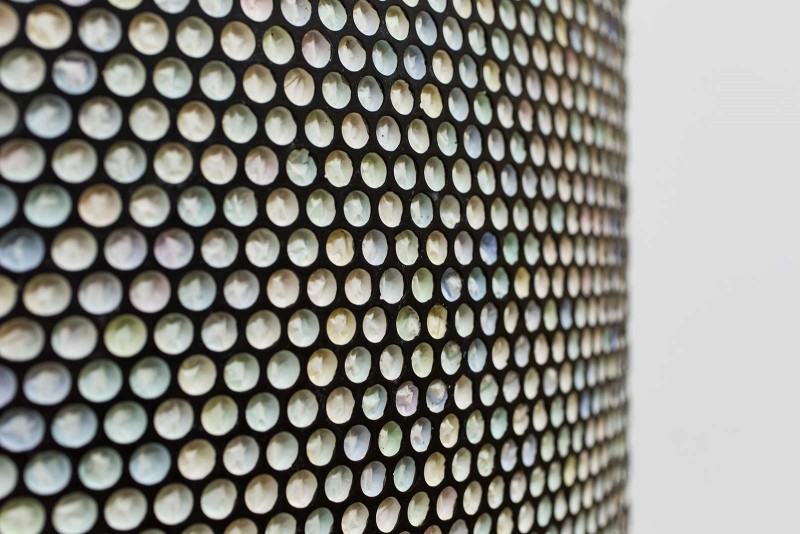
The four other pieces in the show are pairs displayed on opposite sides of the gallery. First, the “Cloud” pair. They are small, curved, painted plaster casts of sheets of bubble wrap. Because photographs do not do them justice, I’ve included here an image of the detail of one them. The word that comes to mind to describe these works is “elegant”. Perhaps “brilliant”. Like “Large Lens,” wonder extracted from the prosaic.
The thread paintings
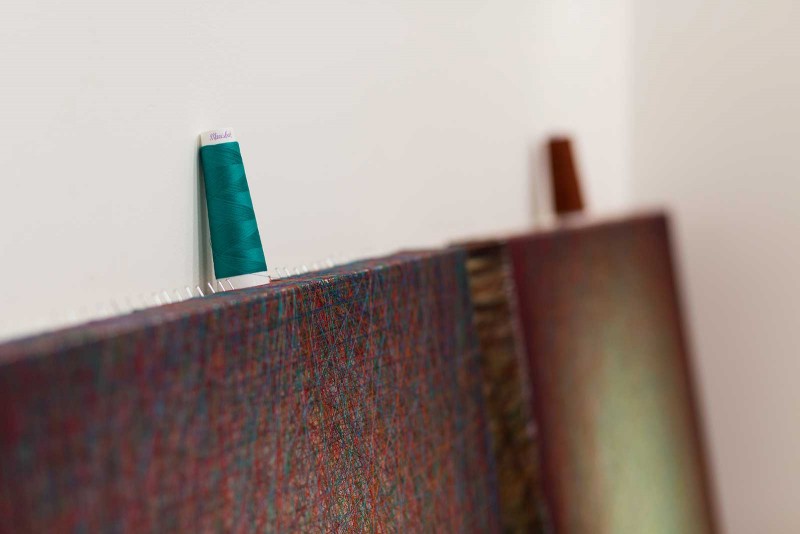
Two thread paintings, titled “Contracting Hum” and “Expanding Hum,” make up the second pair of other works. They are deep, luminous layers and layers of crisscrossed fine, multicolored threads strung over shallow, painted wooden trays, and arranged so that large glowing orbs appear in the center of the pieces. The color combinations of these works create an illusion of depth, opacity, and even motion: the orbs seem to pulse. You feel like you are in the presence of celestial phenomena. Again, photographs do not do them justice. The image above provides a sense of their intricate detail and the almost painterly impression the pieces convey. You can observe the visual effect of the orbs in the paintings, which flank the “Large Lens” in the image displayed at the beginning of this review.
It is difficult to place these exemplars of Lukas’ work into an art-historical perspective. As suggested above, there is a connection to James Turrell, particularly with respect to “Large Lens” and the thread paintings. Both artists have focused upon the optical, spiritual, and emotional effects of luminosity. I also wonder whether Lukas has been influenced by Agnes Martin, particularly by the subtle variations in hue of her beautiful abstract grids, which, like Lukas’s thread paintings, challenge our perceptions.
Emil Lukas was born in 1964 and attended Edinboro University. He has exhibited throughout the United States and abroad and is represented by Sperone Westwater. Lukas lives and works in Stockertown, Pennsylvania, which is about 80 miles north of Philadelphia in the Lehigh Valley.
This show runs through April 10 at the Pennsylvania Academia of Fine Art’s Morris Gallery.


